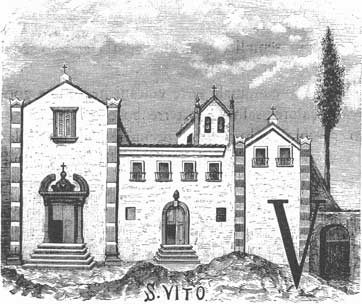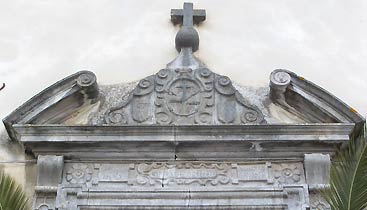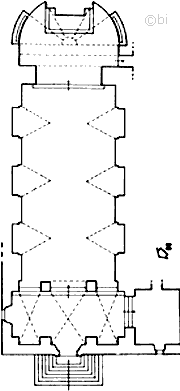SAN VITO
 The Church of San Vito and the adjacent convent of the same name are located in the highest part of the town (the Poggio di San Vito) and overlook the large panoramic square near the oldest and longest road in the town: Via Santi which, starting from Piazza Maddalena (now Piazza Nunzio Azzia), reaches the sanctuary of the Annunziata, in the lower part of Bronte. The Church of San Vito and the adjacent convent of the same name are located in the highest part of the town (the Poggio di San Vito) and overlook the large panoramic square near the oldest and longest road in the town: Via Santi which, starting from Piazza Maddalena (now Piazza Nunzio Azzia), reaches the sanctuary of the Annunziata, in the lower part of Bronte. The building is located on a corner with respect to the square; the typology is typical of a single-nave church with a raised entrance and lava stone stairs, on three sides. The church is certainly of humble origins; "it had a poor and weak birth" writes Benedetto Radice. It was initially built where the sacristy and the corridor of the refectory are now and perhaps, as was the custom at the time in Bronte, it was cemented with clay. No mention is made of either the convent or the church in the report that the bishop of Monreale, Mons. Torres, made on the occasion of his pastoral visit to Bronte in 1574. The first information on its origins is given by P. Gesualdo De Luca in the History of the City of Bronte. In regretting very much for not having precise information he writes that in the aforementioned marriage registers the day of June 1, 1600 is mentioned and that probably towards the end of 1500 «D. Rocco Papotto, at his own expense built the Church of S. Vito, from which later arose the larger one built by the Observant Fathers.» The ancient church and the surrounding land a few decades later were, therefore, granted by the Municipality to the Observant Friars Minor of the Order of Saint Francis to build the convent.
Restorations and renovations
 The first certain news is from October 1589 when the Archbishop of Monreale, in a new pastoral visit to Bronte, ordered that the altar be removed from the church and from 1592, when the Viceroy Count of Olivares ordered "... that for the construction of said convent the meat tax be granted for three years, which amounts to 25 ounces per year". The first certain news is from October 1589 when the Archbishop of Monreale, in a new pastoral visit to Bronte, ordered that the altar be removed from the church and from 1592, when the Viceroy Count of Olivares ordered "... that for the construction of said convent the meat tax be granted for three years, which amounts to 25 ounces per year". From these two dates the small church has undergone numerous restorations and renovations over the centuries:  it was restructured in 1643 (being prior P. Antonio from Bronte); it was restructured in 1643 (being prior P. Antonio from Bronte);
 the inside was restored and decorated in 1879 (by Nunzio Capizzi Monachello); the inside was restored and decorated in 1879 (by Nunzio Capizzi Monachello);
 the apse was completely renewed with rich gildings and ornaments in 1880 (by the dean Giuseppe Ardizzone); the apse was completely renewed with rich gildings and ornaments in 1880 (by the dean Giuseppe Ardizzone);
 the balustrade of the major altar was constructed in 1894 (care of the friar Francesco of Bronte). the balustrade of the major altar was constructed in 1894 (care of the friar Francesco of Bronte).
A final restoration was recently done (2019/2020) with the arrangement of the roof and the facade, the resurfacing of the flooring and the restoration of the internal plaster. In this last work,
simple but precious decorations that embellish the nave were discovered and restored, presumably dating back to the restoration of 1879. There is no information, however, about the construction of the choristers' area, composed of a solid vaulted volume resting on marble columns (access is exclusively from the adjacent convent). It is also certain that the view that Agostino Attinà handed down to us in the drawing published by P. Gesualdo De Luca (History of the City of Bronte, 1883) is, especially in the location of the bell tower, much more beautiful and different from the current form. It appears from the census of 1714 that there were only 8 friars in the Convent, becoming 10 in that of 1736.
The prospect
 On the prospect, simple and tidy, concluded at the top with the tympanum just mentioned, stand out the black shape of the basaltic portal of beautiful proportions, with floral decorations engraved in bas-relief, and the central prismatic flight of steps in lava stone. On the prospect, simple and tidy, concluded at the top with the tympanum just mentioned, stand out the black shape of the basaltic portal of beautiful proportions, with floral decorations engraved in bas-relief, and the central prismatic flight of steps in lava stone.
The inside
The inside to one only nave, with apse and cantor' area, has rich gildings and ornaments which reach the maximum decoration in the hemispherical part of the apse. The church has seven altars: to right Sant' Antonino, San Vito and San Pasquale; to left San Giuseppe, San Francesco and the Crucifix. The major altar, adorned with polychrome marble, is consecrated to the Immaculate Virgin (the wooden statue is precious). On it there are four columns with Corinthian capitals which support the overhang of the frame on which the vault of the dome is set. In the choir loft (accessible only from inside the convent) you can see a wooden choir with seats and backrests connected at the top by an inlaid frame on small columns and sculpted capitals, a revolving legion on a hexagonal base and a painting on canvas depicting a seated Franciscan monk. Next to the convent, once upon a time, there was a small cemetery where the poor were buried (the current Via Campo dei Fiori, see the 1850 map below), a right that the University of Bronte had reserved for itself when it handed over the church to the Friars Minor.
|